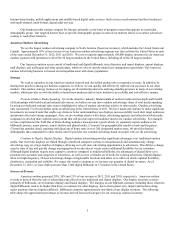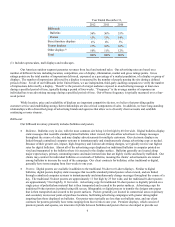iHeartMedia 2012 Annual Report Download - page 17
Download and view the complete annual report
Please find page 17 of the 2012 iHeartMedia annual report below. You can navigate through the pages in the report by either clicking on the pages listed below, or by using the keyword search tool below to find specific information within the annual report.14
In the United States, federal law, principally the Highway Beautification Act (“HBA”), regulates outdoor advertising on
Federal-Aid Primary, Interstate and National Highway Systems roads within the United States (“controlled roads”). The HBA
regulates the size and placement of billboards, requires the development of state standards, mandates a state’s compliance program,
promotes the expeditious removal of illegal signs and requires just compensation for takings.
To satisfy the HBA’s requirements, all states have passed billboard control statutes and regulations that regulate, among other
things, construction, repair, maintenance, lighting, height, size, spacing and the placement and permitting of outdoor advertising
structures. We are not aware of any state that has passed control statutes and regulations less restrictive than the prevailing federal
requirements on the federal highway system, including the requirement that an owner remove any non-grandfathered, non-compliant
signs along the controlled roads, at the owner’s expense and without compensation. Local governments generally also include
billboard control as part of their zoning laws and building codes regulating those items described above and include similar provisions
regarding the removal of non-grandfathered structures that do not comply with certain of the local requirements. Some local
governments have initiated code enforcement and permit reviews of billboards within their jurisdiction challenging billboards located
within their jurisdiction, and in some instances we have had to remove billboards as a result of such reviews.
As part of their billboard control laws, state and local governments regulate the construction of new signs. Some
jurisdictions prohibit new construction, some jurisdictions allow new construction only to replace existing structures and some
jurisdictions allow new construction subject to the various restrictions discussed above. In certain jurisdictions, restrictive regulations
also limit our ability to relocate, rebuild, repair, maintain, upgrade, modify or replace existing legal non-conforming billboards.
U.S. federal law neither requires nor prohibits the removal of existing lawful billboards, but it does mandate the payment of
compensation if a state or political subdivision compels the removal of a lawful billboard along the controlled roads. In the past, state
governments have purchased and removed existing lawful billboards for beautification purposes using federal funding for
transportation enhancement programs, and these jurisdictions may continue to do so in the future. From time to time, state and local
government authorities use the power of eminent domain and amortization to remove billboards. Thus far, we have been able to
obtain satisfactory compensation for our billboards purchased or removed as a result of these types of governmental action, including
relocation, although there is no assurance that this will continue to be the case in the future.
We have introduced and intend to expand the deployment of digital billboards that display static digital advertising copy from
various advertisers that change up to several times per minute. We have encountered some existing regulations in the U.S. and across
some international jurisdictions that restrict or prohibit these types of digital displays. However, since digital technology for changing
static copy has only recently been developed and introduced into the market on a large scale, and is in the process of being introduced
more broadly in our international markets, existing regulations that currently do not apply to digital technology by their terms could be
revised to impose greater restrictions. These regulations, or actions by third parties, may impose greater restrictions on digital
billboards due to alleged concerns over aesthetics or driver safety.
ITEM 1A. RISK FACTORS
Risks Related to Our Business
Our results have been in the past, and could be in the future, adversely affected by economic uncertainty or deteriorations in
economic conditions
Expenditures by advertisers tend to be cyclical, reflecting economic conditions and budgeting and buying patterns. Periods
of a slowing economy or recession, or periods of economic uncertainty, may be accompanied by a decrease in advertising. For
example, the global economic downturn that began in 2008 resulted in a decline in advertising and marketing by our customers, which
resulted in a decline in advertising revenues across our businesses. This reduction in advertising revenues had an adverse effect on our
revenue, profit margins, cash flow and liquidity. Global economic conditions have been slow to recover and remain uncertain. If
economic conditions do not continue to improve, economic uncertainty increases or economic conditions deteriorate again, global
economic conditions may once again adversely impact our revenue, profit margins, cash flow and liquidity. Furthermore, because a
significant portion of our revenue is derived from local advertisers, our ability to generate revenues in specific markets is directly
affected by local and regional conditions, and unfavorable regional economic conditions also may adversely impact our results. In
addition, even in the absence of a downturn in general economic conditions, an individual business sector or market may experience a
downturn, causing it to reduce its advertising expenditures, which also may adversely impact our results.
We performed impairment tests on our goodwill and other intangible assets during the fourth quarter of 2012, 2011 and 2010
and recorded non-cash impairment charges of $37.7 million, $7.6 million and $15.4 million, respectively. Although we believe we
have made reasonable estimates and used appropriate assumptions to calculate the fair value of our licenses, billboard permits and
























